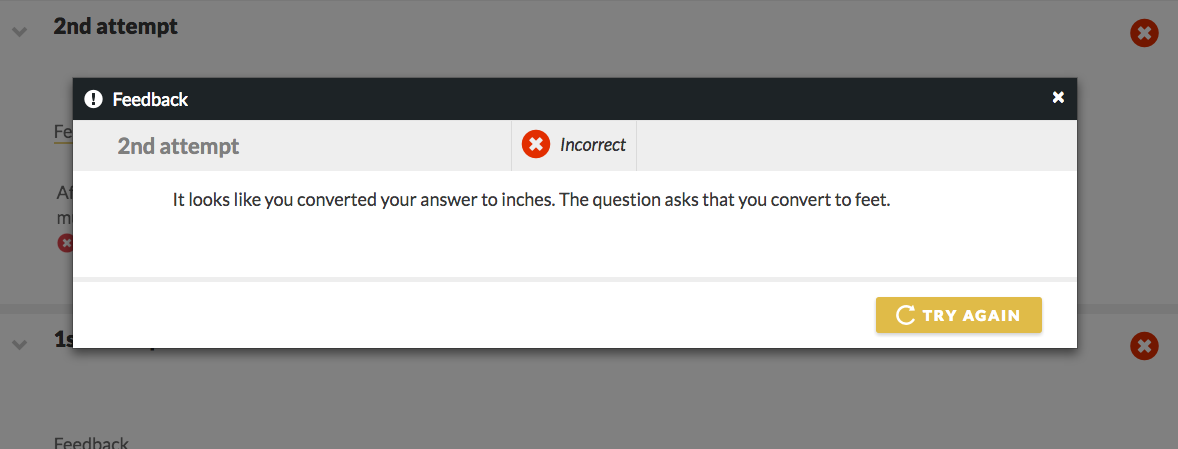The Numeric Entry Module is used to create questions that require students to give their answers in the form a number.
Getting Started
- To insert the Numeric Entry Module in to the Question Text section, click the numeric entry button in the Question Type Palette. The symbol on this button is rectangle that contains the numbers 1, 2, and 3.
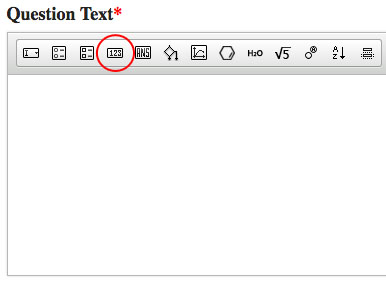
- Once inserted into the Question text section, the module will always appear as a blank rectangle, as exemplified in the screenshot below:

- To open the Numeric Entry Module editor, double click on the module.
The Numeric Entry Module Editor consists of two tabs: an Options tab, in which you define the correct answer, and a Feedback tab, in which you write the feedback students will see when they enter in the correct answer and incorrect answers.
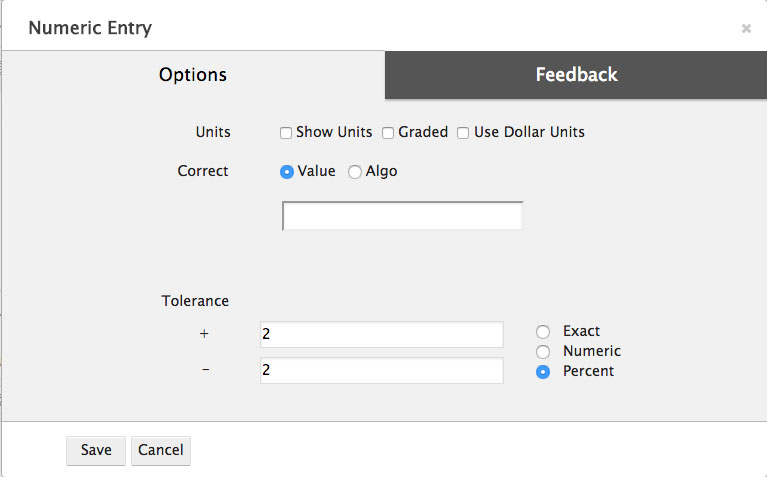
The Numeric Entry Editor also has a Save button, which you can use to save your work and exit the module, and a Cancel button, which allows you to exit the module without saving.
Setting Up the Question
The Options tab allows you to set the correct answer for the question. This includes the “tolerance,” or margin of error for the correct answer, as well as the correct answer’s units.
To set the correct answer, do the following:
- Select whether you want the correct answer to be a specific value, or an algorithm. For an in-depth look at how to create algorithms, please refer to the “Algorithm” documentation.
- If you want your correct answer to be a “Value,” type out your correct answer in the editable text field.
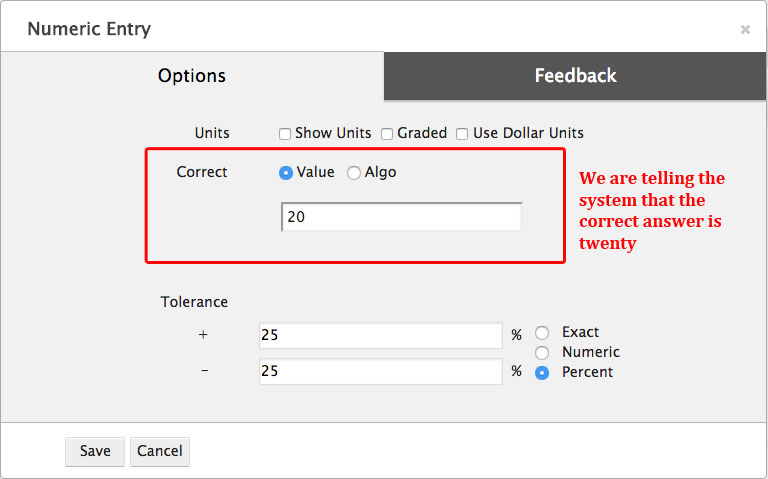
- If your correct answer is a “Value,” you can also write it in scientific notation by doing the following:
i.Type a numeral into the correct answer section.
ii.Type in an asterisk after the numeral. This will reveal a 10 and an editable exponent field.
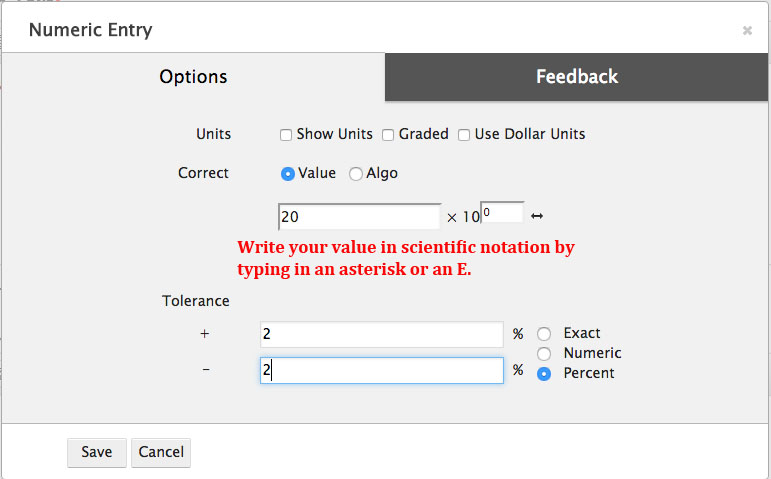
iii.Type in your exponent.
iv.Students can also write their answers in scientific notation by typing an asterisk into the numeric entry field.
- If you want your correct answer to be an “Algo,” select the algorithm you want to use as your correct answer in the dropdown menu.
- In the “Units” section, determine whether you want the system to take units into account when displaying or grading the correct answer. Do this by selecting one of the following options:
- Show Units - This will reveal an editable text field next to the correct value. Insert the unit value you want the student to see when typing out the correct answer. This unit value will auto-populate in student view.
- Graded – This will also reveal an editable text field next to the correct value. Insert the unit value you want the student to include when typing out the correct answer. When “Graded” is checked, the student must manually insert the unit value as part of her answer.
- Use Dollar Units – This will tell the system to auto-populate the Units field with a dollar sign. Students will see the dollar sign when typing out the correct answer. Currently, you cannot use the “Use Dollar Units” option in conjunction with the “Graded” option.
- If you do not want the system to display units, do not check any of the unit options.
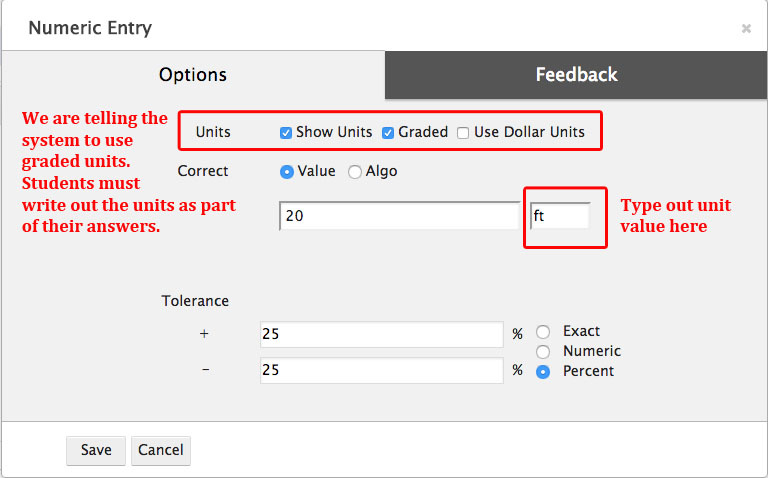
- Set the tolerance, or the margin of error, of answer values that the system should accept as correct, by selecting either “Exact,” “Numeric,” or “Percent” in the Tolerance section. Then fill out the margin of error in the editable text fields.
- Exact – This option tells the system to only accept the correct value as correct. Selecting this option will prevent you from entering a margin of error. Note: Exact does not grade for significant figures.
- Numeric – This option tells the system to accept answers that fall within a certain margin of error as correct. For example, if your correct answer is 20 and you were to set a Numeric tolerance of ± 2, the system will accept all answers between 18 and 22 as correct.
- Percent – This option tells the system that the margin of error is a percentage of the correct answer. For example, if your correct answer is 20 and you were to set a Percent tolerance of ± 25%, the system will accept all answers between 15 and 25 as correct (with 5 being 25% of 20).
- If your tolerance is a decimal, the system requires you to enter a leading zero.
- Your upper tolerance and lower tolerance do not have to match.
- Save the module.
Creating Feedback
The Feedback tab allows you to write feedback that students will see when they select an answer choice.
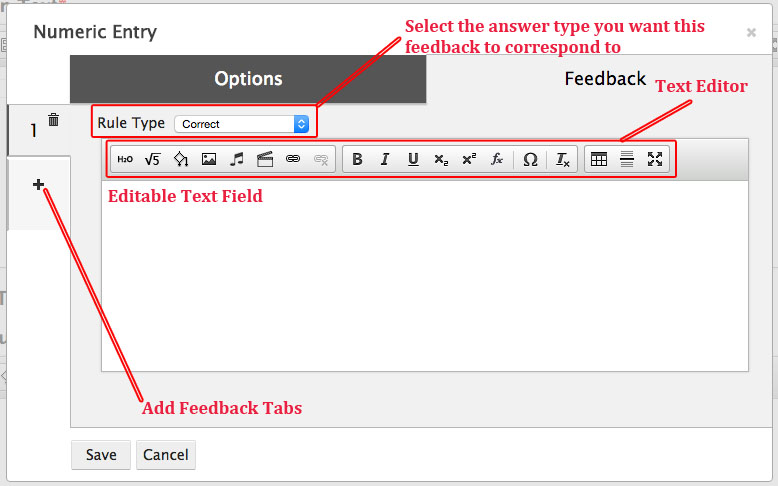
You can create Correct feedback, which a student will see when she types out the correct answer, and Default feedback, which a student will see when she types out an unspecific incorrect answer. If your correct answer has Graded units, default feedback will also be triggered if the student inserts the numeric part of the correct answer, but the incorrect units. Additionally, you can create feedback for specific incorrect answers as well.
You do not have to set Specific Incorrect feedback if you set Default feedback. However, check with your editor for best practices.
Furthermore, it is good practice to set the Correct feedback and Default feedback first.
Text Editor
Each Feedback tab contains a text editor, which allows you to add text and other multimedia to the answer options.
Important Note: Copying and pasting text from a Word Document into Smartwork5 could insert formatting that will corrupt the module. Please enter the text directly into the Text Editor, or copy and paste from a plain text document.
The Media Palette allows you to insert multimedia as answer options.

From left to right, the Media Palette allows you to do the following:
- Insert chemical equations
- Insert a symbolic (math) equation
- Insert algorithmic variables
- Insert image files
- Insert music files
- Insert video files
- Insert hyperlinks
- Remove the hyperlinks
The Text Formatting Palette allows you to format text, as well as add special characters.

From left to right, the Text Formatting Palette allows you to do the following:
- Bold text
- Italicize text
- Underline text
- Insert subscripts
- Insert superscripts
- Insert math formulas *This button is being phased out. To insert math formulas, use the symbolic equation editor.
- Insert special characters
- Remove any formatting applied to the text
Furthermore, the Feedback Formatting Palette allows you to do the following:

- Insert tables
- Insert line breaks
- Edit text in full screen mode
Correct and Default Feedback
To set Correct Feedback, do the following:
- In the Rule Type section of one of the feedback tabs, select “Correct” from the Rule Type dropdown menu.
- In the text field, type up what you want the student to see when she answers the question correctly. Add any media you see fit using the palettes in the Text Editor.
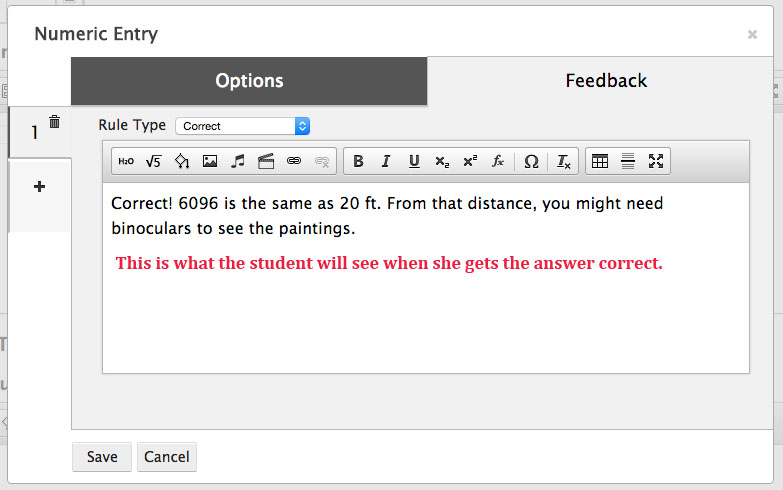
- Save the module.
- Go to preview mode in the question editor. Check to see that the feedback is working correctly by inserting the correct answer in the preview window. If you set a tolerance around your correct answer, you should also check to see that answers within that tolerance trigger the correct feedback.
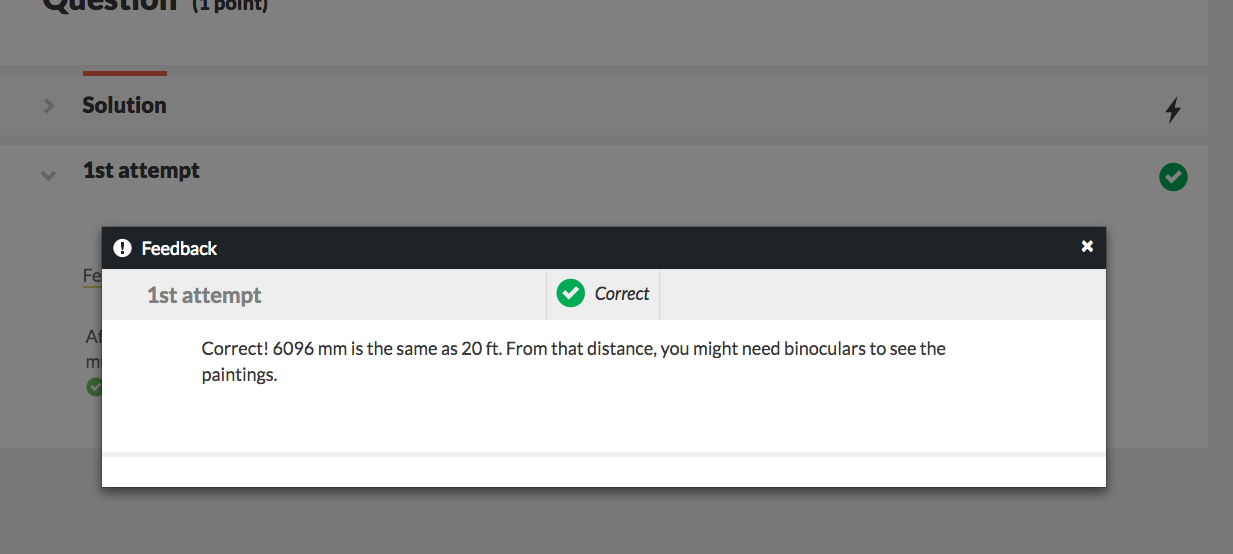
To set Default feedback, do the following:
- In the Rule Type section of one of the feedback tabs, select “Default” from the Rule Type dropdown menu.
- In the text field, type what you want the student to see when the student gives an incorrect answer. Add any media you see fit using the palettes in the Text Editor.
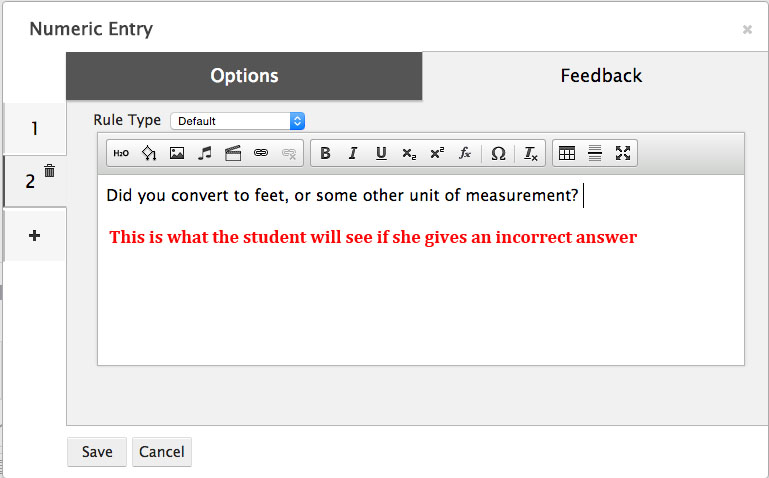
- Save the module.
- Go to preview mode in the question editor. Check to see that the feedback is working correctly by inserting an incorrect answer in the preview window.
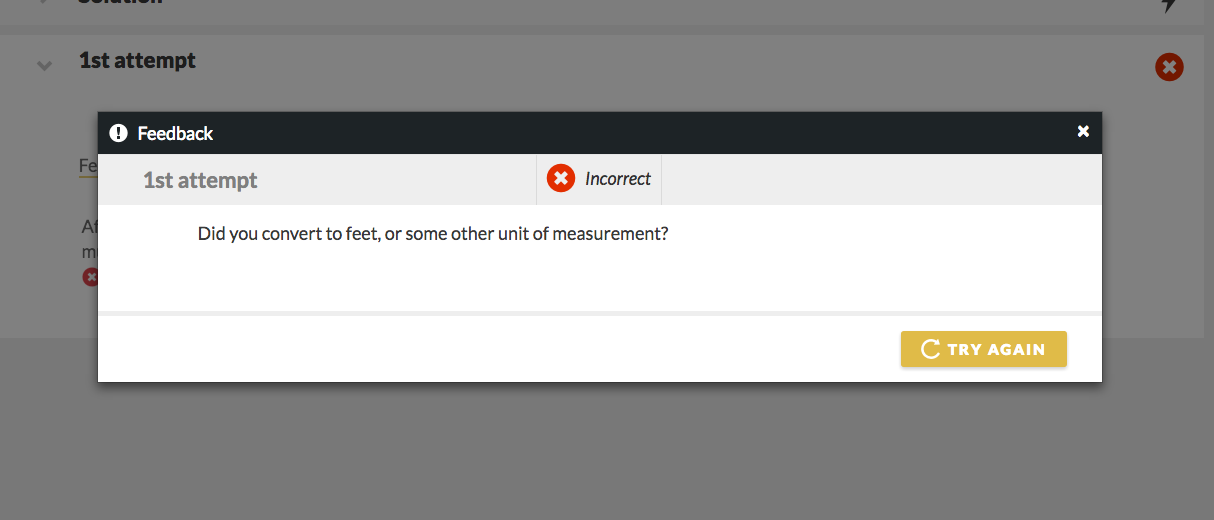
Specific Incorrect Feedback
You can also create feedback for specific incorrect answers, allowing you to trap for specific mistakes a student may make.
To create Incorrect feedback for specific answers, do the following:
- In the Rule Type section of one of the feedback tabs, select “Incorrect Value” from the Rule Type dropdown menu.
- In the feedback tab, determine if you want the incorrect answer for which you are trapping to be a value or an algorithm.
- Type out the incorrect answer if you chose value. If your incorrect answer is an algorithm, select your incorrect answer from the dropdown of algorithm variables.
- Be sure that your incorrect answer does not fall within the tolerance you set for the correct answer.
- You cannot specify incorrect units in a Specific Incorrect Feedback tab. If your correct answer has Graded units, the system will continue to evaluate the units a student types in against the units you specified as correct.
- Select the tolerance, or margin of error, for your incorrect answer. Be sure that your incorrect answer’s tolerance does not fall within the tolerance you set for the correct answer. If your tolerance is a decimal, please include a leading zero.
- Type out the feedback you want the student to see when she triggers this incorrect answer in the editable text field. Format your feedback as desired.
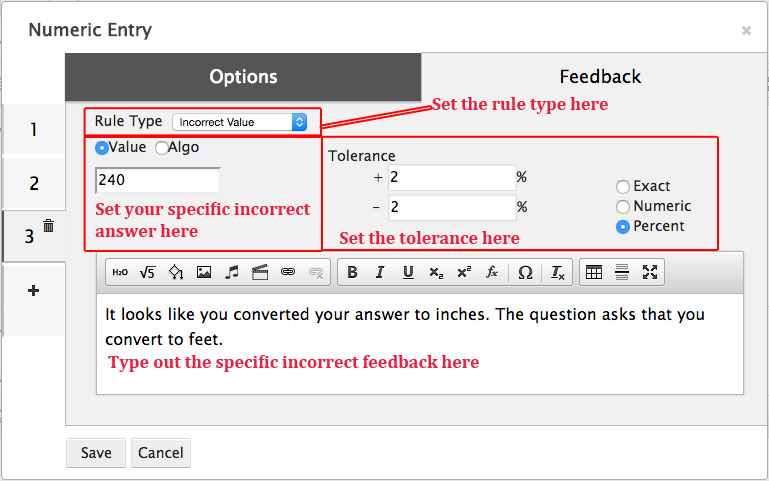
- Save the module.
- Go to preview mode in the question editor. Check to see that the feedback is working correctly by inserting the specific incorrect answer in the preview window. If you set a tolerance around your specific incorrect answer, you should also check that answers within that tolerance trigger the specific incorrect feedback.
